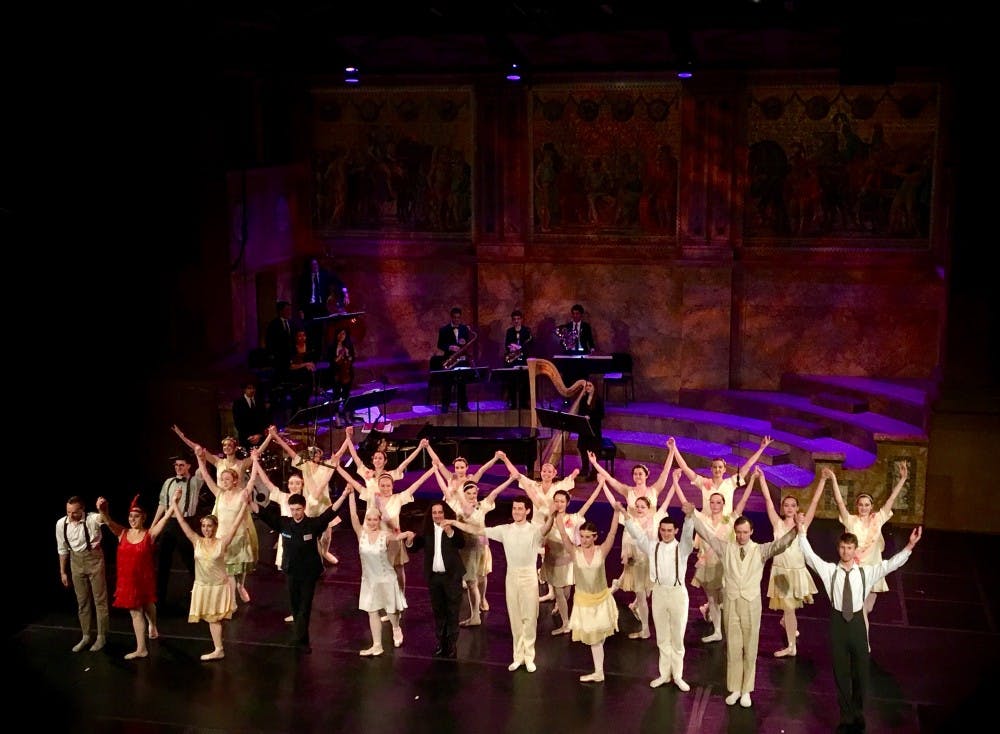It was a fatal moment. It was a beautiful moment. It was one of those moments when you could foresee the destruction of something fragile, but you held your breath nonetheless.
A ray of dazzling light was projected onto the right corner of the stage. Jay Gatsby emerged following the ray, dressed in pure white. He glided onto the stage with the grace of a ballet dancer and lay down on the floor, floating in an imaginary pool of bright illusions and imminent doom.
Only 20 feet away, but as if in another dimension, George Wilson, played by Alexander Quetell ’17, climbed onto the balcony above to seek revenge for his wife Myrtle’s death. I do not remember when the music stopped, but suddenly silence enveloped the theater, and then two gunshots exploded. The pure white silhouette faded as the light dimmed. The storyline spiraled downward, and all was lost.
This scene marked the climax of Princeton University Ballet’s world premiere ballet production of The Great Gatsby, a story told and retold. However, this story is not commonly told through ballet. Just as time has transformed F. Scott Fitzgerald’s University into our University, PUB takes on the challenge of transforming a novel of rich literary heritage to a non-textual expression of original movements and music.
I entered Richardson Auditorium without much experience watching ballet performances. As an avid fan of the original novel, I appreciated this near-fresh mindset, as I was able to see what was special about the ballet narrative of this familiar story.
During the show, I spent most of the time marveling at the success of this transformation. Costumes, music, lighting, and, of course, the dancing — oh, the dancing! All these artistic elements joined to bring life to the stories of Gatsby and Daisy Buchanan, of Daisy and Tom Buchanan, of Tom and Myrtle Wilson, and of smaller characters like George Wilson.
I was particularly fascinated by the choreography in the scene in which Gatsby, played by Aaron Hilton ’20, and Tom, played by Peter Deffebach ’17, engaged in a physical tug-of-war for Daisy. The scene was set in New York City, where Gatsby pressures Daisy to deny loving Tom and the two men get into a fight. Daisy’s wavering hesitation, Gatsby’s fervent persuasion, and Tom’s angry possessiveness were expressed in the most passionate physical forms, as Daisy fluttered in rapid steps across the stage between two men, as Gatsby embraced Daisy lovingly in a deep dip, and as Tom advanced towards Gatsby in threatening steps.
While the choreography for Myrtle, played by Dana Fesjian ’17, seems less “perfect” — a lot less orthodox, a lot more wild and unrefined — it defied my view of ballet’s stereotypical elegance. Even to an amateur like me, some kicks or jumps seemed like they were not quite there, yet they did not feel like blunders. Her imperfections were organic: It was a kind of ballet that belonged to the streets. The choreography vividly sketched the image of Myrtle as a lower-class woman with fierce vitality and desire to advance. The bright red color of Myrtle's dress complemented her character — fiery, passionate, and unapologetic — standing out among the other characters’ predominantly white and golden attire.

With a dancing style similar to Myrtle’s, her husband George Wilson was another character who instantly captured my attention. His solo dance was a translation of Wilson’s literary monologue into ballet, an exposition of the character’s interior that did not exist in the novel. Although Wilson triggers the unfortunate plot twist in the story, he presented to me an exciting discovery of serendipity in reality. As I watched his solo, I noticed that the lighting worked out in a way that cast the shadow of his dancing figure onto a part of the inner wall of the auditorium. I could not help staring at the devilish, unfathomable dancing shadow on the wall. I remain curious as to whether the lighting crew made this arrangement on purpose, but I know for sure that for those who noticed the effect, this visualization of Wilson’s dark psyche cast a memorable impression.
The ballet narrative was so captivating that, during the epilogue part of the show, I felt uneasy when Nick Carraway, played by William Keiser ’19, stopped dancing and started reading an excerpt from the original novel. To me it seemed unnecessary because it interrupted the audience’s immersion in the world of movement, and almost felt like an anticlimactic way to wrap up the show. Fully convinced by the dancers’ abilities to express and impress, I would rather see an uninterrupted closure of the story expressed through ballet — for example, a more explicit performance of Gatsby’s funeral — as opposed to this “snap” out of the narrative.
Despite this temporary detachment, I was absolutely won over by the performance of PUB dancers, the beauty of the music and the subtlety of the lighting throughout the show. As the dancers departed from the stage, a green light started flashing from the top right of the auditorium. I stared at it and remembered how Gatsby would stare at it across the bay. As powerful as the green light, a successful adaptation like this eventually brings its audience back to the story itself. I thought about how like Gatsby, I was waiting for it to appear the whole time, and then someone behind me murmured under her breath, “The green light!” I smiled, knowing I was not alone.









